307: My ritual is panic.
Hullo
Lincoln
Battlefields
The Next Big Thing
One Hand ;)
Bees
Links
Bye
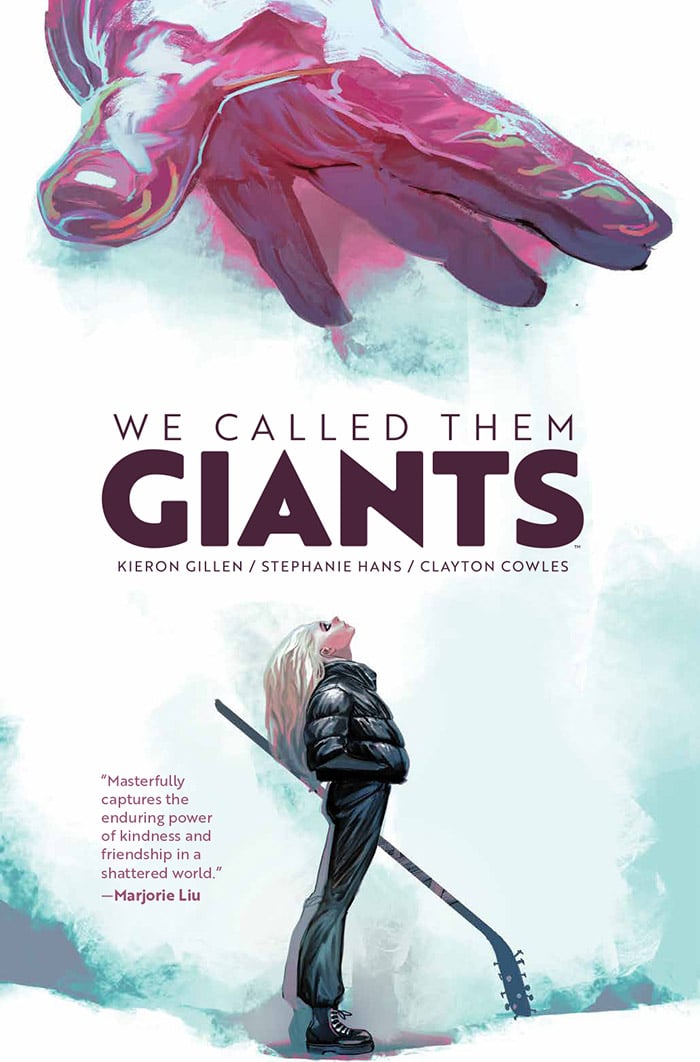
We Called Them Giants is out in comic shops today. At least, many Comic Shops – apparently those shops who get all their books from Diamond get theirs at the same time as the normal book shops (November 13th). Amazon kindle apparently said it'd be delayed too, but I just got told someone said it just downloaded, so I guess it may be on digital (US UK CA)? And I did just get a mail which says it's a week late in the UK, though there will be copies at our launch tomorrow at GOSH. So (er) don't rush to the shops in the UK, but if I see you tomorrow you can get one?
There's many problems in getting into comics, but me having to write paragraphs which posit the book exists in some kind of quantum released/not-released state is a bit extra.
That said, in some ways, it is appropriate. A book release. It's not like the a serial comic release, and the Wednesday or nothing. It's a graphic novel. It moves at its own pace – moving from Stephanie, Clayton and My brains, to the page, to the printer, to bookshops and hopefully, eventually to the person in a Library who really needs it. It's a book meant for many people, but there's certainly some people who I explicitly hope find it. You'll get to it when you get to it, and I hope you do. It's a stand alone story, but it's in it for the long run.
It's a hard one to talk about without giving it away – which isn't saying it's a big twist book, but it is a big vibe book, and its charm is a lot about that. It's about a girl – Lori – who wakes up to find a weird rapture-like event has happened, and nearly everyone has gone. We quickly move into a soft fable-style post-apocalypse, like as if the moody edge of Pixar shot the Walking Dead.
And they arrive, and everything changes.
I say it's a story about communication across a chasm at the end of the world, and all those leaps of faith we make to live. It absolutely came from the lockdown years, though likely not in the way folks would guess. It's also the most beautiful single volume Stephanie has ever done – a big part of the goal was to write a short, self-contained work that Stephanie could do and look at a whole, without worrying about single issues. She did that, and it's everything you could hope for.
It's a big mood, and was written to live with you, and I'm glad it's in your hands.
Here's the first three pages, just to have a taste of some art...



And here's some from later…
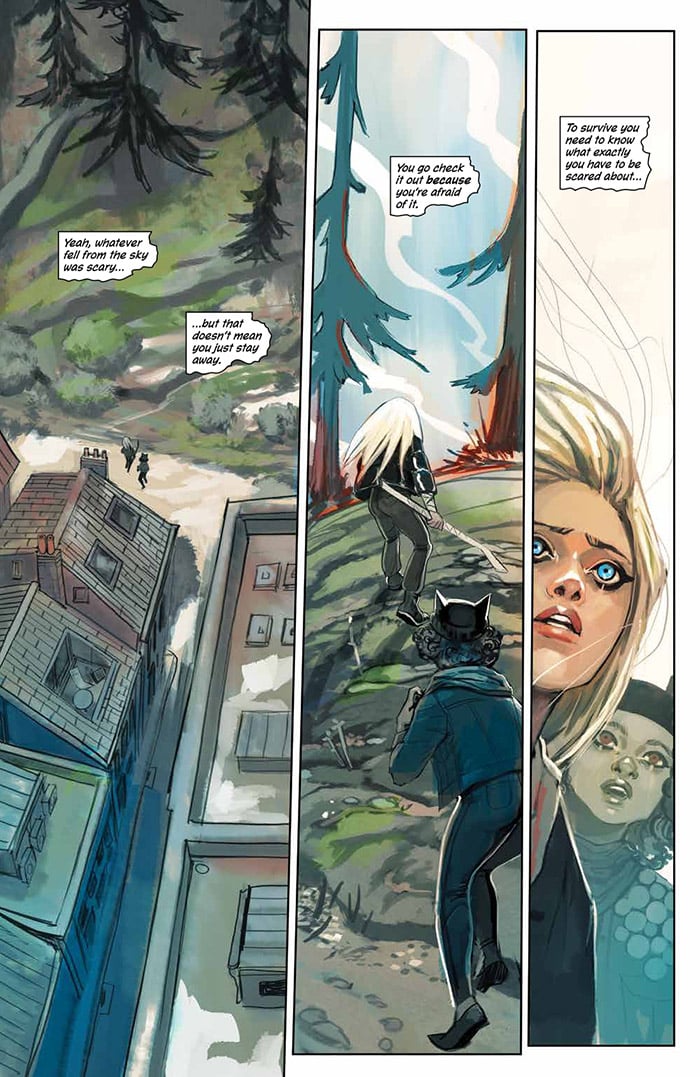
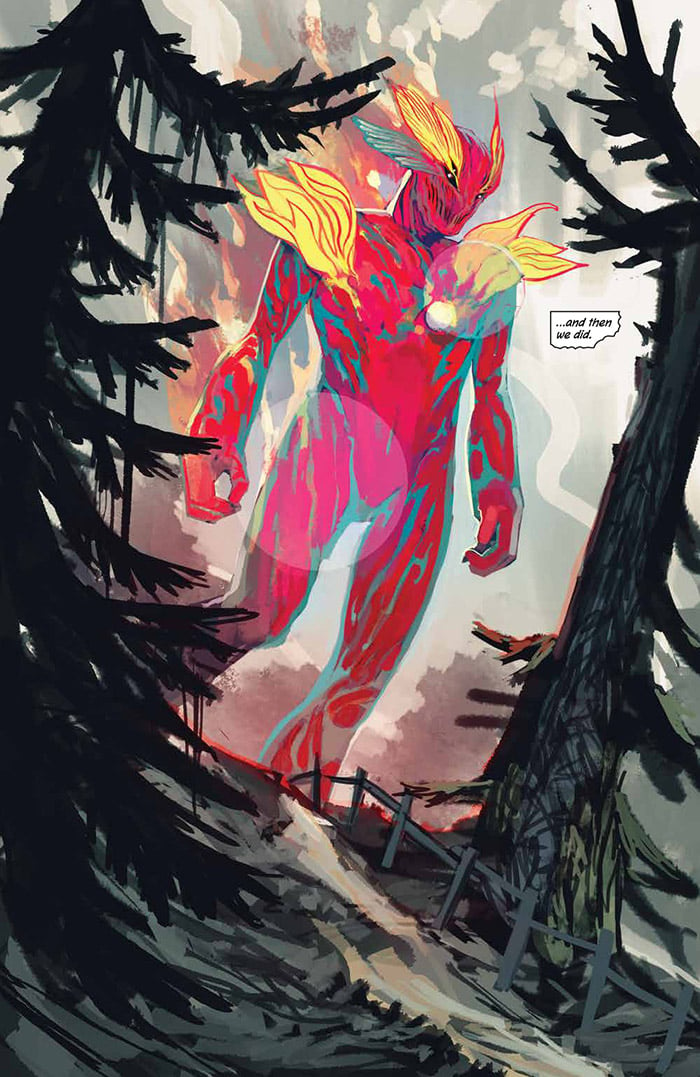
Stephanie and I are at GOSH in London tomorrow night, where we'll be having a launch party.
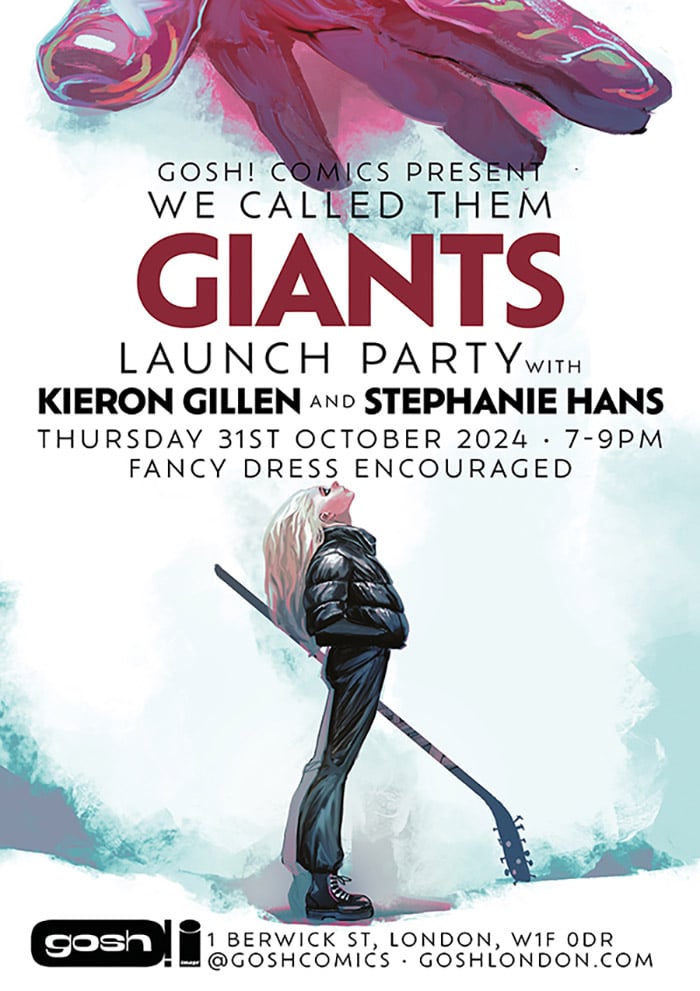
Come say Hi and get a copy. As it's Halloween, it's optional fancy dress, but I still don't know what I'm wearing. Maybe I'll pretend to be a writer.
I suspect I'll write some more when it hits the bookshops (I kind of want to try and do a trailer?) but it's out there, and I hope you dig it.
If you want to know more, a good place to go is over to the League of Comic Geeks – I'm doing an AMA with that turncoat Jamie McKelvie tomorrow to celebrate its launch (and the launch of Jamie's One For Sorrow next week), so you can ask questions about anything.

Also out this week is DIE ADVENTURES: LOVE IS A BATTLEGROUND which is the second DIE supplement.
Three scenarios! The eponymous LOVE IS A BATTLEFIELD by me - a 1 v 1 duet variant of DIE where you're a couple playing strange conflict resolution wargame in lieu of attending proper therapy. POWERSWORD PURGATORY by Zedeck Siew is a love letter to that most British of gaming pastimes – Warhammer 40,000 – but we’ve filed off all the serial numbers and resprayed the Space Marines so no-one will be the wiser. SUNDAY NIGHT WARFARE by Basheer Ghouse features players lead their forces to victory or defeat in a strange otherworld, can they come to terms with the fact that their armies of toy soldiers are suddenly real people with dreams, desires and fears?
Yes, the theme is "Wargames” but it comes from it from all sorts of oblique angles. I think it's the most experimental of the three Scenarios volumes – mine came from being challenged to write a 1v1 DIE game. Which I did... but it's also very much its own thing, and makes me want a more classic DIE 1v1 game too.
It's available from your gaming/comic shop and direct from RRD. If you buy a hard-copy, you also get the PDF, so it can be with you instantly.
We also announced the next one in the back of the collection, but we can talk about that soon. We've got a bunch of plans for DIE RPG next year. I have had my idea for my new con megagame, which I want to see if I can get working. It involves a lot of string.
The Power Fantasy 4's FOC was on Monday, so Caspar went and did a quick teaser, and I busted up Photoshop to try and add a couple of things and then Jamie McKelvie fixed my blacks, as I suck. Let's include it here...

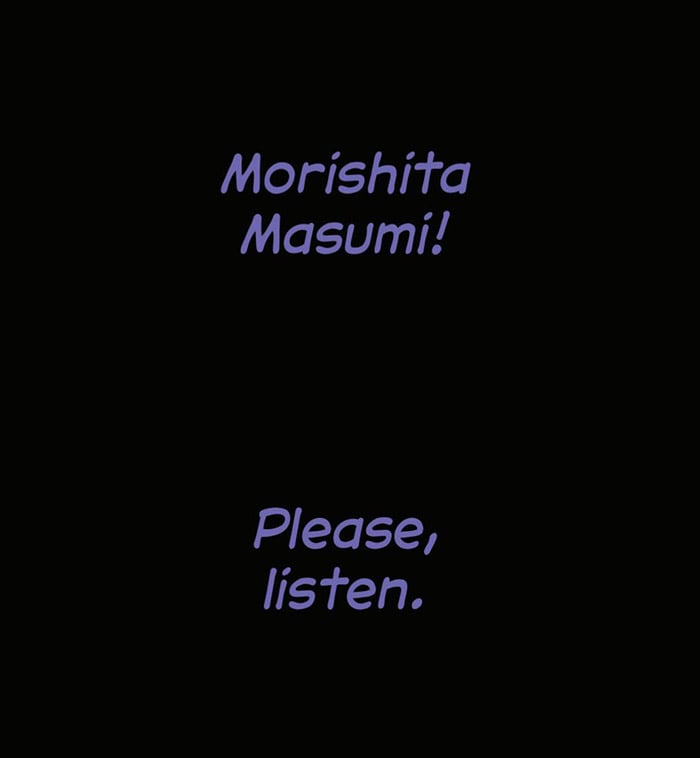
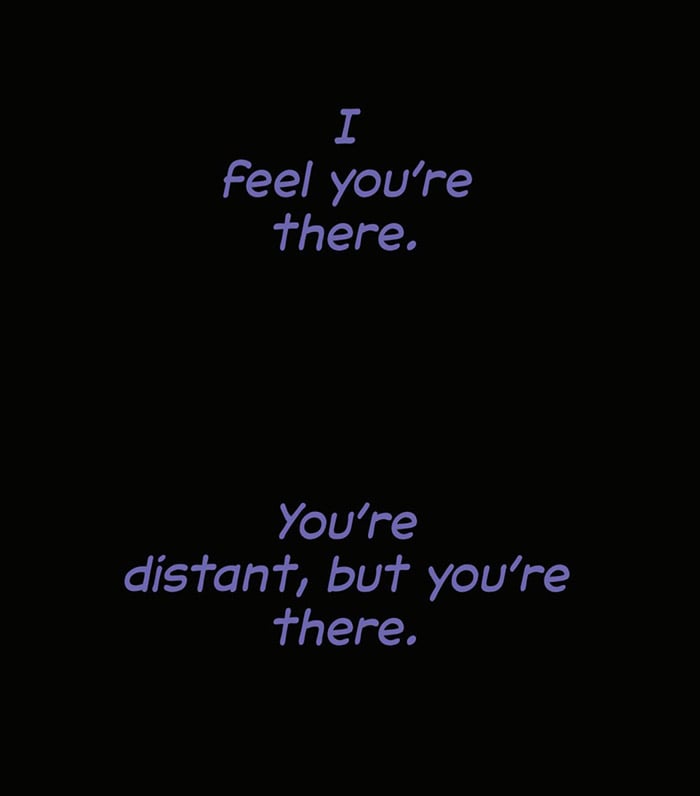

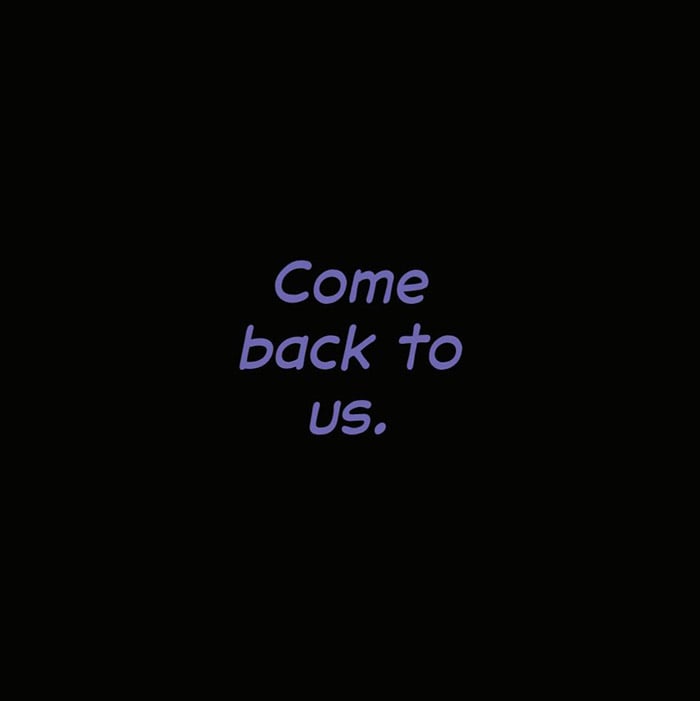
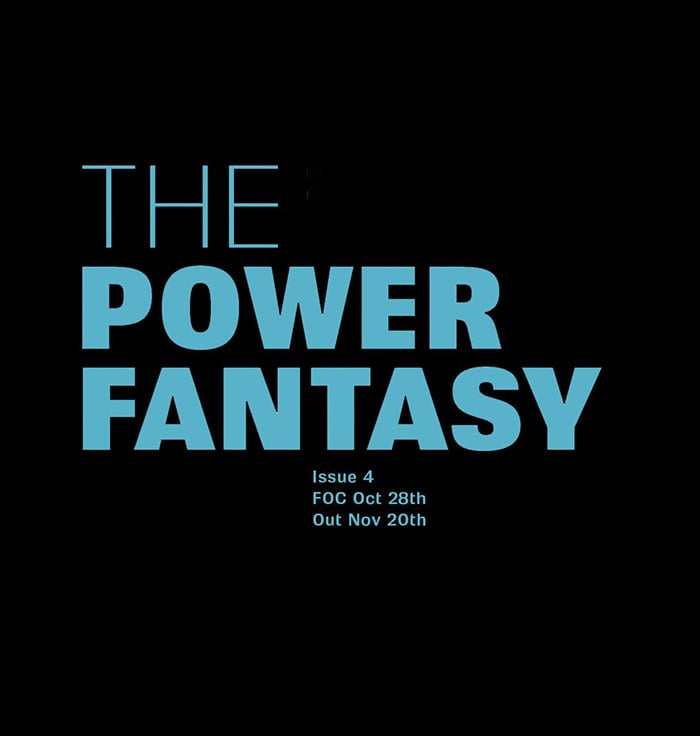
I quite like doing these. I want to do a post-release one for 3, if I can find time this week (which I may not, for reasons you'll see in my outro mail).
How issue did issue 3 go down? It went down well. Some reviews are here and we realised we're the best reviewed new book of 2024, at least via Comic Book Round Up's math, which is nice. And as I was writing this, ComicsXF have just published their commentary article here, which is always good to see.
Some interviews from NYCC went live – here's Caspar and me talking to the very lovely Comic Pals and here we are talking to Comic Book Club which includes the full transcript. I'll highlight the Comic Book Club’s one, as it's the first place we've talked about issue 3. It was pretty magical seeing how it had landed as we hoped it would for them. Here's a quote, actually...
Obviously, Kieron, you’re a very meticulous writer. You do your research, you build your bibles, etc. But for both of you, this is locking you into certain things. So how much did you have to do in advance in terms of the writing to make sure this timeline works? And in terms of the art, Caspar, how much do you have to be like, Okay, I’ve got to be thinking about this event visually that happens in issue 12.
Wjingaard: There were key moments in the plot, which we’re going to get to eventually, key moments in the history… They were the starting points of the conversation. So when I was doing a lot of the design, I was basing it around those key events, because they are people that we’ve not met that are involved with those events, and there’s people in future events that we’ve not met. So we built the bigger pillars first, and then spread out from it.
Gillen: So much of the plotting was actually about, I’ve got this whole timeline, the details, all the history, and then, okay, when do I reveal… We’ve got this present-day plot, initiated by America, trying to kill Heavy. So we’ve got an ongoing plot there. We’ve also got the back story. So when do we choose to fill in? Because you need to fill in enough to make everything meaningful. But also if you do too much… Originally, I was going to do issue three as issue two, but I realized, no, we need to have more forward momentum on the plot before we can go back in time. So all the stuff, we already know. The question, when do we choose to show it? And that is the trick, as in life, I had to basically sit down and do the tight plotting for the first 16 issues. We’ve got more stuff to reveal as well. [Laughs] I know that will be revealed in the first 16 issues. Okay, when do we reveal this? What’s the best way to do that? I did the synopsis. Okay, this looks good. This looks like it could work. Do it. So basically, I just did the work.
So you started with a timeline, and then glommed on plot. When did the characters come in?
Gillen: The characters came first, and then it’s like, how would they change the timeline we had? We started with iconic names. Etienne was the mind. Masumi was the artistic monster. Heavy was the free radical. We started with iconic ideas. And we had more. We mentioned the Queen a few times, in the second Summer of Love. We’ve mentioned the Signal. We’ve mentioned the Signal a bunch.
Wjingaard: Those were the first two designs I made, The Signal [and The Queen]… They’re a big deal in the book.
We're enjoying ourselves, in short.
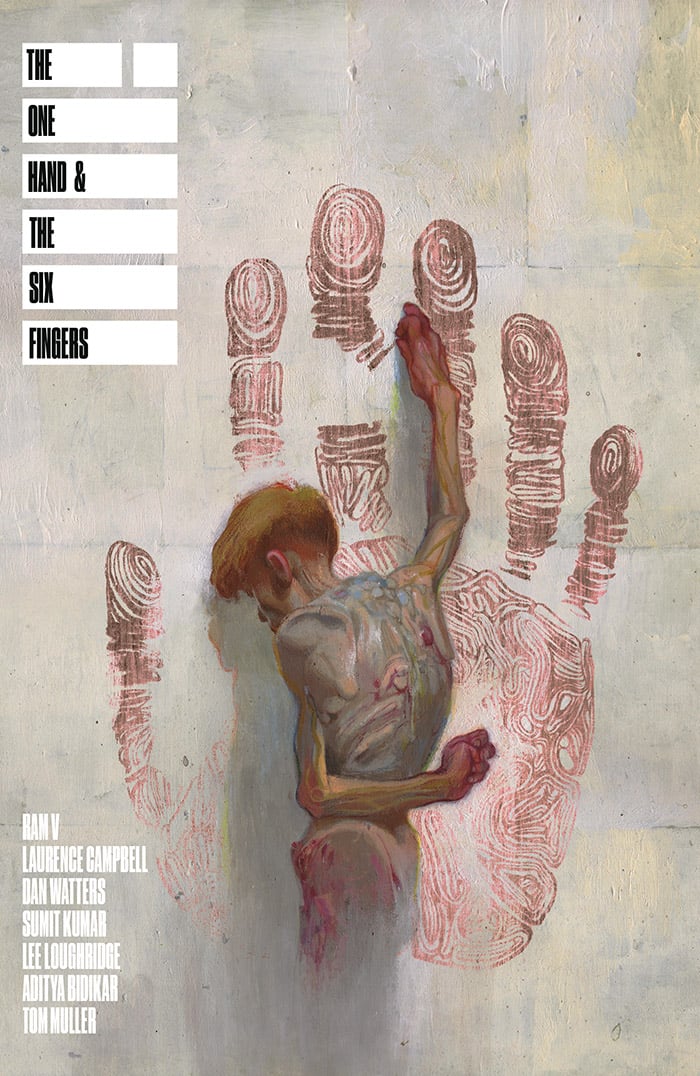
As you may have seen in The Power Fantasy #3, we didn't do an interview profile this time. I was spinning too many plates to manage to do one. However, it returns in issue 4, where I talk to Ram V and Dan Watters about THE ONE HAND AND THE SIX FINGERS, which is being collected in a single huge volume for December.
You'll see my profile piece then, but here's the whole interview.
Basics - hunter and pursued across two minis, a connection strongly hinted but published separately... how did you see this going down? How did you hope folks would respond? How did they?
Ram: I’ve always been fascinated by the idea of extending the preoccupation of the book beyond its own boundaries. This is the first time, we thought of extending that to the format / reading cadence. By splitting the story across two books, I think we allowed each issue to challenge and reframe the reader’s assumptions. And so with every issue we had this re-examination of where people thought the story was going. That sort of conversation, puzzling, pondering was what I’d hoped this would encourage. In terms of how it reflected in readers picking up the books - there was some confusion at first, as is to be expected, but eventually word of mouth and reviews and I imagine retailers spread enough of the word that most of the readership, to my eye was reading both books.
That said, I met a reader at a recent signing who said they read only one book and loved it. I found it very amusing to hear that. He hadn’t even heard of the other book!
Dan: We wanted to create a mystery the reader was invited into. And we were able to use the direct market format to play with that directly. It’s not like we abjectly hid the fact that these books were connected- we shared design across the books, and all our main covers were connecting covers across the two titles- but by not signposting that openly, soliciting the books separately, we let readers figure that out for themselves, or loop each other in. I definitely saw people online getting excited when, having picked up one book on a whim, they realized there was a whole other side to the mystery. That’s what we were hoping for. Both books are detective stories at their core- the idea was to try and build another one for the reader to participate in.
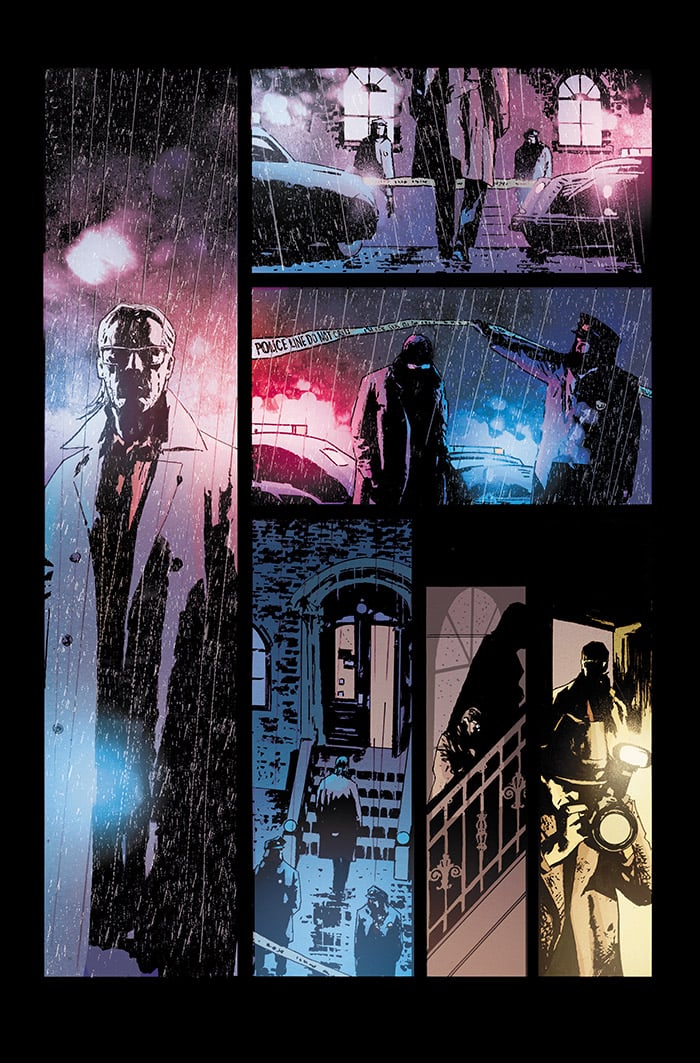
This is coming out as a single, huge trade. What was the thinking to present it like that? The issues were presenting them as these separate entities, revolving one another. This collapses the experiment into something that hits differently - how did you make the decision? I found it a really interesting example of creating single issues and trades which feel different from one another?
Ram: Yeah, the original intention had always been to release the whole thing as one collection at some point. We did consider two trades first, but interestingly ran into the problem that book-shops, at least the larger ones don’t quite engage with the idea that in-store or reader-to-reader conversation can change / affect how you buy/read a book. We figured we only had one shot to convey what the book was and so we put it together this way.
Dan: There was some back and forth on this. As to whether we released each book in its own trade, then collected it all in hardcover afterwards. But ultimately, this is the intended reading experience for the book. They’re meant to alternate, and that wouldn’t work the same if you were sitting down with two separate trades. We also considered buying habits. The monthly floppy has an aura to begin with- it’s generally a part of a larger story mosaic, where you know you aren’t necessarily getting a complete product. It’s a chapter. Whereas a miniseries trade is done in one- and once it’s out, it’s there on the shelf. It didn’t seem to us to have the same propensity to provoke discussion as the books would in the window in which the singles were releasing every month.

Okay - I said the first bit was basics. It's not really. The origins of this one. I know you two sit in the pub and make plans and schemes. When did this come together? And just as importantly, why now?
Ram: It was a combination of reading McCarthy’s Sunset Limited AND listening to a podcast on post-work societies (also a Dan recommendation) that really set of the idea in my head. A dialogue about existential purpose set against the backdrop of an artificial habitat meant to keep its occupants…engaged, not happy, but engaged.
I hadn’t really articulated that until now. But that was the idea that made me call Dan at 2 am and talk about doing these two books!
Dan: Ram called me up at 2am because he’d had an idea, and he knew I’d still be up writing at 2am. We’d been in a mutual phase of binging Cormac McCarthy, swapping recommendations back and forth, and The Sunset Limited had sparked an idea for him. He wanted to tell two sides of a story, but he only had one side of it. He thought I might have the other, and I did. I actually had the seeds of what The Six Fingers turned into percolating in the back of my mind- the idea of a killer mutating as he was hunted- but I knew it needed something else to make it sing. So the two projects immediately became very symbiotic.
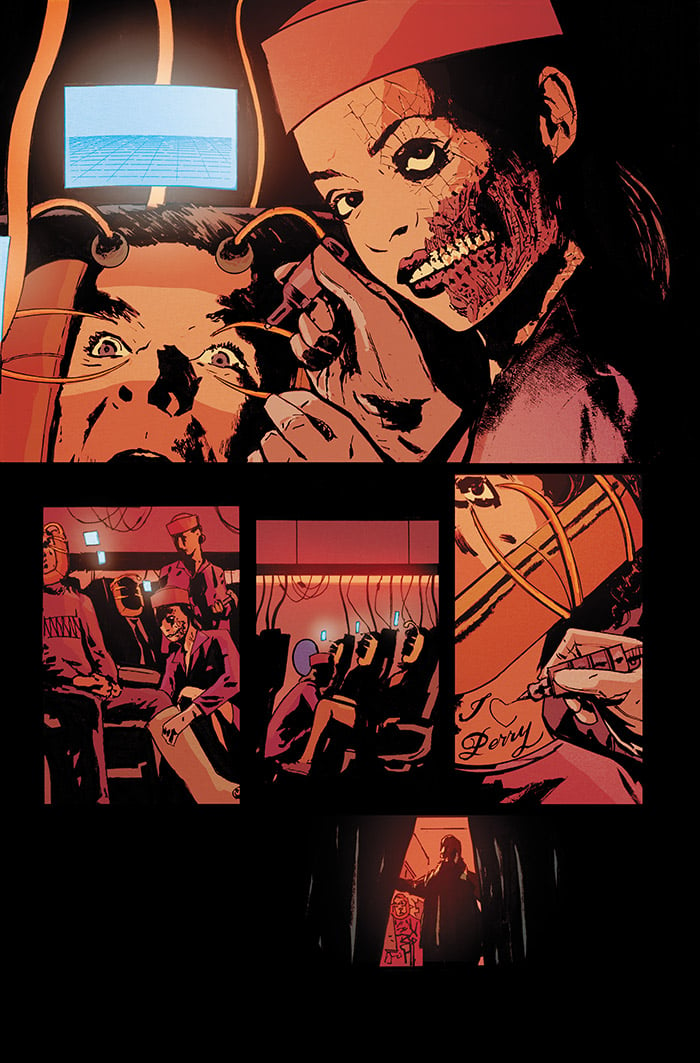
A little about execution. How did you construct the fucker? Plot it? Write it - is it back and forth, or something else? Do you dabble in one anothers' books, or was that each one was yours a sacred part of the experiment? And hey - how much creative rivalry was there in this? I'm aware that in the few times I've written something tightly with someone else, while I don't want to be better than my partners, I certainly don't want to be worse...
Ram: Yeah it all happened quite organically, in conversation, back and forth, at pubs, over zoom calls. I think stories want to make patterns and for me, some of the most exciting moments in writing are when my brain recognises a pattern I didn’t know I was creating. It’s that moment, for me, when a story really comes together. The pieces all fit and you can see the bigger picture. You have to trust that’ll happen. If you have any measure of that intangible storyteller instinct, that’ll happen.
Now put two people together (and I think Dan has that nebulous storyteller magic-dust in oodles) - and you begin to see those patterns in each other’s story, it’s almost easier to see it someone else’s work, I think. And the more we started having those moments, the more I felt sure this was going to work.
Creative competitiveness is good. It pushes you. It pushed me, certainly. I’ve admired Dan’s work on more than one occasion. I didn’t pay much attention to that aspect of it here. Never really thought of it as creating two things. Always felt like jamming with a fellow musician! Wanting to keep up, add, synthesise.
Dan: We started with a premise and an ending. After that, issue by issue, it was very much a call and response. There was a lot of checking in with each other- mostly telling each other the state of our current issue’s outline in the pub. That was very good for sparking ideas back and forth- I might mention a location or event I was thinking of including, and Ram would go “ah, I can use that! That fits with something I need to happen in my next issue.” That happened quite a lot in that sort of synergous, magical thinking kind of way we’re all scared to dissect too much lest it stop bloody working.

It's a fascinating story - it's driven by these really interesting use of images which haunt the city, shapes on the page becoming objects in teh world and panels and back and forth. It's very COMICS, if you know what I mean, and it finds a way to really hit its Dick-ian themes. There's certain images the two teams conjure here which sting and linger. What were you trying to do with this stuff?
Ram: A long time ago, in some New York food court, Deniz Campbell and I talked about things that defined comics / comic writing / comic art. And we’d lingered over the idea that a lot of good comics visual storytelling was about good design.
Good drawing yes. But the way a narrative is designed visually, is a huge component of storytelling. The art tells the story in individual panels of course. But when there is synergy in art and symbolism, in juxtaposition and insinuating relationships— you do end up with something quite evocative that doesn’t necessarily articulate what you want to say but creates enough narrative tension that the reader’s mind creates connections and narrative threads. At the risk of sounding new-age-y about it, there is some sort visual shamanism there.
I think Laurence and Sumit work and see the page in a similar vein. And there are such moments in the books that were born in their minds.
Dan: First off, thank you. And something that’s definitely been a focus of mine over the recent part of my career is training myself to be more of a visual thinker. Ram’s instinctually very good at that, so I saw the opportunity to step up my game a bit in this collaboration. One of the biggest joys was realizing during the last issue that I could probably pull off the entire last section without words. Everything that needed to be said out loud had been said, and we could watch the final dominos cascade in silence. That felt like a success.
Having the artistic collaborators to pull those kinds of tricks was also paramount. Both Sumit and Laurence have such a strong sense of storytelling that they knew when slowing things down, focussing on seemingly insignificant details, could let them snowball into something thematically important.
Finally... how do you feel about it? Would you ever do anything like it again? Would you urge someone else to?
Ram: I loved it. It’s the most mentally engaged I’ve felt in a project in a long time. So it’s also draining and time-consuming in a way other books aren’t.
I’d love to do something like it again, but it has to be different and meaningful to the story in some way. And those ideas don’t come along too often. I’d work with Dan again in a heartbeat, of course.
Would I urge someone else to do it? Yes - but not exactly this. Do something new! Invent! I’d love to see more creators really pushing what can be done with the medium, format and play with its expectations.
Dan: I enjoyed the hell out of it. I think we set out to do something, and we did it.
I don’t know that I’d do exactly this again or urge someone else to do the same. Because we just did it. But I would very much encourage people to play with the medium and pull the unique foibles of the direct market into their storytelling. How people experience art is affected by how they’re able to consume it. So why not utilize that? I’m sure there are hundreds of ways we didn’t even consider. That’s what’s exciting to me.
You can pre-order a copy of The One Hand And The Six Fingers before Monday November 1st, or buy it in December.
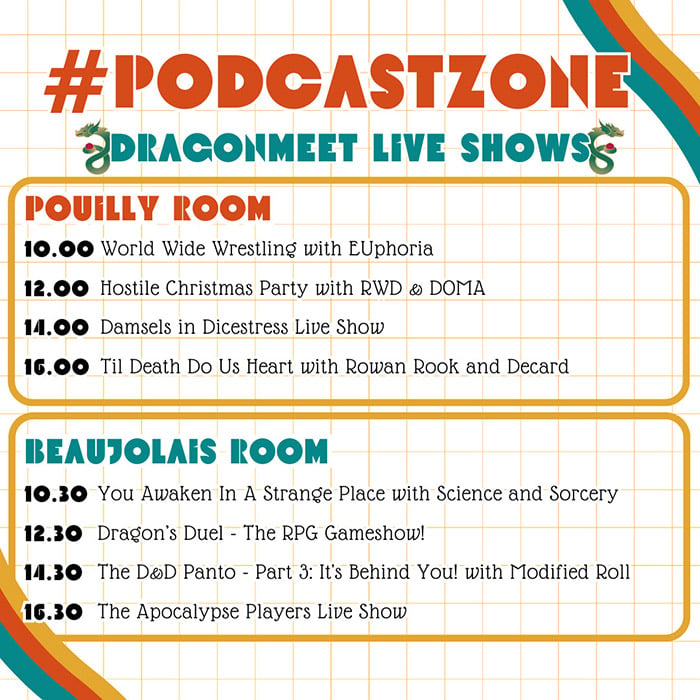
I'm pleased we ended on TO DEATH DO US HEART, but I did go and bat for Groove Is In The Heart.
This piece on Avatar Therapy for treatment of Acute Psychosis was fascinating, living at the boundary of what I understand of magic and what I understand of games. It's all going well, and then has an awful stinger when they are planning to try and let an AI do it.
C's Poetry E-anthology is through its latest run, and really worth jumping aboard. If you want a taste, I felt this one was especially fun.
I've plugged The Between on backerkit before, but I did a thread pointing at its designer Jason Cordova's thread. I was going to turn this into a short essay here, but I realise this is already a long one. As BlueSkies is readable, you can click through here and read it and Jason's too. As I say in the thread, I think it's worth reading ESPECIALLY if you're primarily exposed to more traditional D&D-y RPGs – Jason lays out exactly what a game like this can do to actually make the players look like superstars. You can also back it here.
While we're talking RPG stuff, TEETH is the current Bundle of Holding. Co-created by my Ludocrats co-writer Comrade Rossignol, it's Blackadder does Stalker, basically, and well worth getting. The Zines alone are a delight.
David Harper looks at the weirdness around present shipping, a topic I clearly am somewhat invested in. Behind
the paywall, but you should be backing Sktchd if you want to support fine comics discourse. DavidThe Stop Project 2025 Comic Site is worth looking at if you haven't already. It's a collection of petrifying stuff.
What a week.
I'm tempted to leave it like that. Chrissy just walked into the kitchen and said that her day has been like that bit near the end of Goodfellas where Ray Liotta is trying to cook the food while going all over town to get cocaine, which gives the energy this household vibrates with at the mo.
I can make you understand in a single, sentence: we're moving house a week today.
We both had rituals planned – I was hoping to do a London Orbital Redux and walk from where we lived in Archway to where we live in Lewisham, a route that would hit the majority of my iconic London places. Except clearly not. I'm no longer in my 20s and leaving Bath. I'm nearly 50, and I'm moving to bath. I don't have rituals. I have panic. My ritual is panic.
Sidestepping everything else (and the house-moving isn't even the complete everything else) the actual backbone of generative work has been The Power Fantasy #6, which Caspar will need at some point next week. He's wrapping issue 5 at the moment, which is going great – strong, smart choices throughout. We were texting last night and I had a bit of an endless rant about Preppy Golfwear. We're also pulling together the trade design brief, weighing up options. It will inevitably be beautiful, as Rian is doing it, but we obsess. But basically, I should be able to wrap TPF6 on Friday, have Katie look after that, I edit on Monday and then have all my artists fed for 6 weeks or so as I Am Moving Into A House Which Is Really Not Ready To Be Moved Into.
In other words, I wouldn't expect a newsletter next week, and if you get one, it will likely just read SEND HELP.
Speak soon.
Kieron Gillen
London
30.10.2024